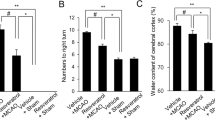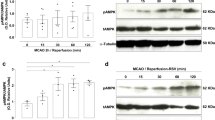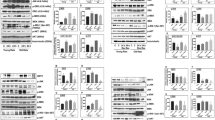Abstract
Previous studies have provided evidences that resveratrol can protect the brain from ischemia/reperfusion injury; the mechanisms of its neuroprotective effects remain unknown. To investigate whether resveratrol has neuroprotective effects on ischemia and reperfusion injury and whether resveratrol exerts its neuroprotective effects through inhibition of calpain proteolysis of TRPC6, a transient middle cerebral artery occlusion (MCAO) model was employed in rats. Western blot analysis was performed to detect the protein levels of aII-spectrin, transient receptor potential canonical (subtype) 6 (TRPC6) and phosphorylated cAMP/Ca2+ response element-binding protein (p-CREB). The immunoreactivity of p-CREB and TRPC6 were measured by quantum dot-based immunofluorescence analysis. Our results showed that MCAO rats showed large cortical infarct volumes and neurological scores. By contrast, resveratrol, when applied for 7 days before MCAO onset, significantly reduced infarct volumes and enhanced neurological scores at 24 h after reperfusion, and these results were accompanied by elevated TRPC6 and p-CREB activity and decreased calpain activity. When MEK or CaMKIV activity was inhibited by the addition of PD98059 or KN62, the neuroprotective effects of resveratrol were attenuated, and we observed a correlated decrease in CREB activity. Our results demonstrated that resveratrol prevented the brain from ischemia/reperfusion injury through the TRPC6–MEK–CREB and TRPC6–CaMKIV–CREB pathways.





Similar content being viewed by others
References
Baur JA, Sinclair DA (2006) Therapeutic potential of resveratrol: the in vivo evidence. Nat Rev Drug Discov 5:493–506
Choi DW (1996) Ischemia-induced neuronal apoptosis. Curr Opin Neurobiol 6:667–672
Clapham DE (2003) TRP channels as cellular sensors. Nature 426:517–524
Clapham DE, Montell C, Schultz G, Julius D (2003) International Union of Pharmacology. XLIII. Compendium of voltage-gated ion channels: transient receptor potential channels. Pharmacol Rev 55:591–596
Csiszar A (2011) Anti-inflammatory effects of resveratrol: possible role in prevention of age-related cardiovascular disease. Ann N Y Acad Sci 1215:117–122
Du W, Huang J, Yao H, Zhou K, Duan B, Wang Y (2010) Inhibition of TRPC6 degradation suppresses ischemic brain damage in rats. J Clin Invest 120:3480–3492
Ginsberg MD (2008) Neuroprotection for ischemic stroke: past, present and future. Neuropharmacology 55:363–389
Hung CW, Chen YC, Hsieh WL, Chiou SH, Kao CL (2010) Ageing and neurodegenerative diseases. Ageing Res Rev 9(Suppl 1):S36–S46
Jackson JR, Ryan MJ, Hao Y, Alway SE (2010) Mediation of endogenous antioxidant enzymes and apoptotic signaling by resveratrol following muscle disuse in the gastrocnemius muscles of young and old rats. Am J Physiol Regul Integr Comp Physiol 299:R1572–R1581
Jia Y, Zhou J, Tai Y, Wang Y (2007) TRPC channels promote cerebellar granule neuron survival. Nat Neurosci 10:559–567
Li Y, Jia YC, Cui K, Li N, Zheng ZY, Wang YZ, Yuan XB (2005) Essential role of TRPC channels in the guidance of nerve growth cones by brain-derived neurotrophic factor. Nature 434:894–898
Li H, Yan Z, Zhu J, Yang J, He J (2011) Neuroprotective effects of resveratrol on ischemic injury mediated by improving brain energy metabolism and alleviating oxidative stress in rats. Neuropharmacology 60:252–258
Longa EZ, Weinstein PR, Carlson S, Cummins R (1989) Reversible middle cerebral artery occlusion without craniectomy in rats. Stroke 20:84–91
Mattson MP, Cheng A (2006) Neurohormetic phytochemicals: low-dose toxins that induce adaptive neuronal stress responses. Trends Neurosci 29:632–639
Menzies SA, Hoff JT, Betz AL (1992) Middle cerebral artery occlusion in rats: a neurological and pathological evaluation of a reproducible model. Neurosurgery 31:100–106, discussion 106–107
Montell C, Birnbaumer L, Flockerzi V (2002a) The TRP channels, a remarkably functional family. Cell 108:595–598
Montell C, Birnbaumer L, Flockerzi V, Bindels RJ, Bruford EA, Caterina MJ, Clapham DE, Harteneck C, Heller S, Julius D, Kojima I, Mori Y, Penner R, Prawitt D, Scharenberg AM, Schultz G, Shimizu N, Zhu MX (2002b) A unified nomenclature for the superfamily of TRP cation channels. Mol Cell 9:229–231
Neumar RW, Meng FH, Mills AM, Xu YA, Zhang C, Welsh FA, Siman R (2001) Calpain activity in the rat brain after transient forebrain ischemia. Exp Neurol 170:27–35
Raval AP, Dave KR, Perez-Pinzon MA (2006) Resveratrol mimics ischemic preconditioning in the brain. J Cereb Blood Flow Metab 26:1141–1147
Saver JL (2011) Improving reperfusion therapy for acute ischaemic stroke. J Thromb Haemost 9(Suppl 1):333–343
Subramanian M, Balasubramanian P, Garver H, Northcott C, Zhao H, Haywood JR, Fink GD, MohanKumar SM, MohanKumar PS (2011) Chronic estradiol-17beta exposure increases superoxide production in the rostral ventrolateral medulla and causes hypertension: reversal by resveratrol. Am J Physiol Regul Integr Comp Physiol 300:R1560–R1568
Tai Y, Feng S, Ge R, Du W, Zhang X, He Z, Wang Y (2008) TRPC6 channels promote dendritic growth via the CaMKIV-CREB pathway. J Cell Sci 121:2301–2307
Tsai SK, Hung LM, Fu YT, Cheng H, Nien MW, Liu HY, Zhang FB, Huang SS (2007) Resveratrol neuroprotective effects during focal cerebral ischemia injury via nitric oxide mechanism in rats. J Vasc Surg 46:346–353
Vivien D, Gauberti M, Montagne A, Defer G, Touze E (2011) Impact of tissue plasminogen activator on the neurovascular unit: from clinical data to experimental evidence. J Cereb Blood Flow Metab 31:2119–2134
Vosler PS, Brennan CS, Chen J (2008) Calpain-mediated signaling mechanisms in neuronal injury and neurodegeneration. Mol Neurobiol 38:78–100
Wang X, Teng L, Li A, Ge J, Laties AM, Zhang X (2010) TRPC6 channel protects retinal ganglion cells in a rat model of retinal ischemia/reperfusion-induced cell death. Invest Ophthalmol Vis Sci 51:5751–5758
Wu JM, Hsieh TC (2011) Resveratrol: a cardioprotective substance. Ann N Y Acad Sci 1215:16–21
Zhang C, Siman R, Xu YA, Mills AM, Frederick JR, Neumar RW (2002) Comparison of calpain and caspase activities in the adult rat brain after transient forebrain ischemia. Neurobiol Dis 10:289–305
Zhou J, Du W, Zhou K, Tai Y, Yao H, Jia Y, Ding Y, Wang Y (2008) Critical role of TRPC6 channels in the formation of excitatory synapses. Nat Neurosci 11:741–743
Zhu DY, Lau L, Liu SH, Wei JS, Lu YM (2004) Activation of cAMP-response-element-binding protein (CREB) after focal cerebral ischemia stimulates neurogenesis in the adult dentate gyrus. Proc Natl Acad Sci U S A 101:9453–9457
Zinkstok SM, Vergouwen MD, Engelter ST, Lyrer PA, Bonati LH, Arnold M, Mattle HP, Fischer U, Sarikaya H, Baumgartner RW, Georgiadis D, Odier C, Michel P, Putaala J, Griebe M, Wahlgren N, Ahmed N, van Geloven N, de Haan RJ, Nederkoorn PJ (2011) Safety and functional outcome of thrombolysis in dissection-related ischemic stroke: a meta-analysis of individual patient data. Stroke 42:2515–2520
Conflict of interest
The authors declare that they have no conflict of interest.
Author information
Authors and Affiliations
Corresponding author
Additional information
Yun Lin, Fang Chen, and Jiancheng Zhang contributed equally to this work.
Rights and permissions
About this article
Cite this article
Lin, Y., Chen, F., Zhang, J. et al. Neuroprotective Effect of Resveratrol on Ischemia/Reperfusion Injury in Rats Through TRPC6/CREB Pathways. J Mol Neurosci 50, 504–513 (2013). https://doi.org/10.1007/s12031-013-9977-8
Received:
Accepted:
Published:
Issue Date:
DOI: https://doi.org/10.1007/s12031-013-9977-8




